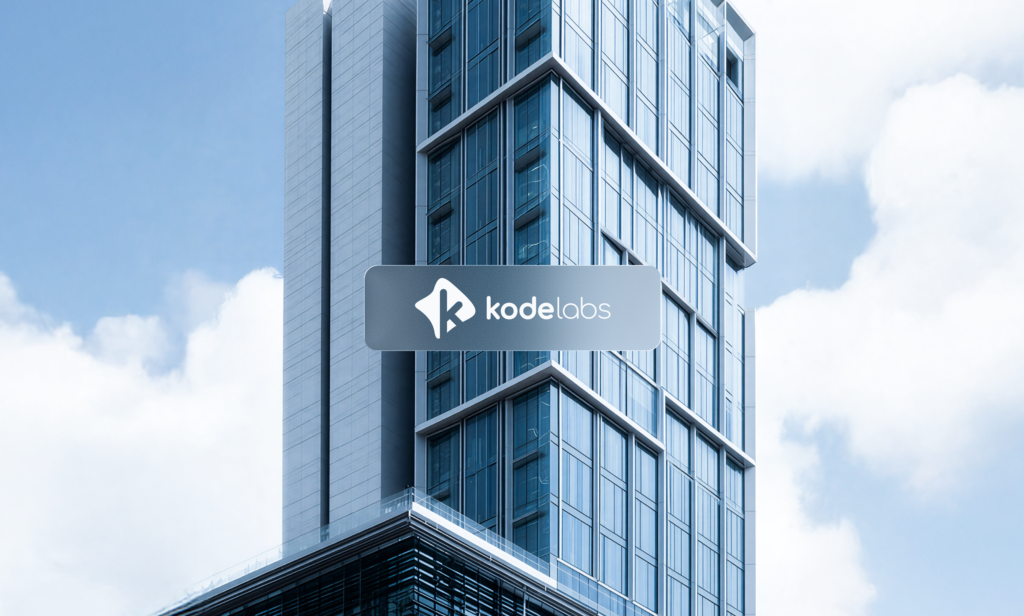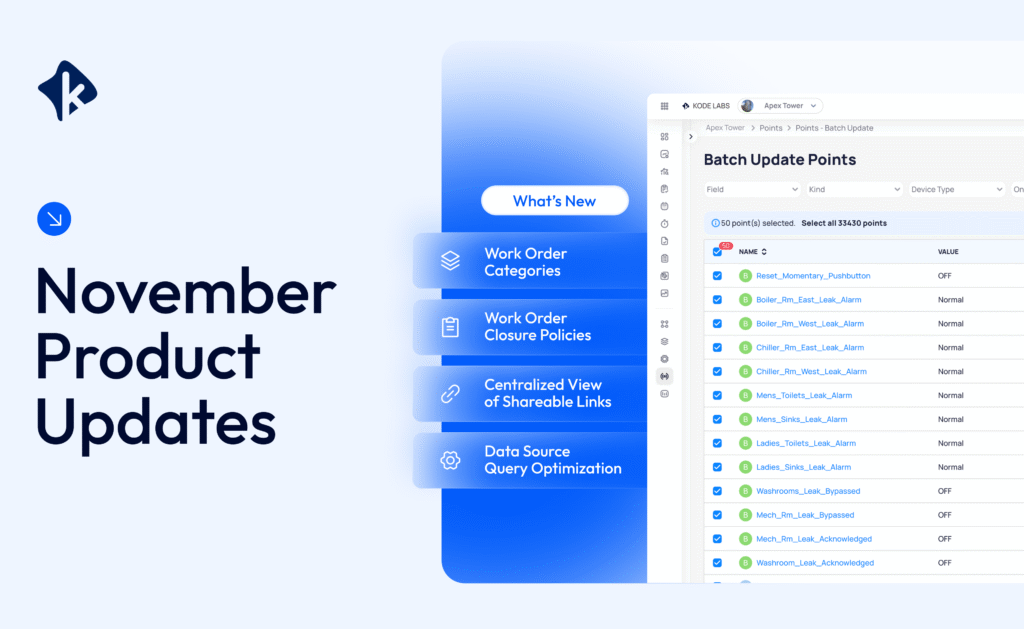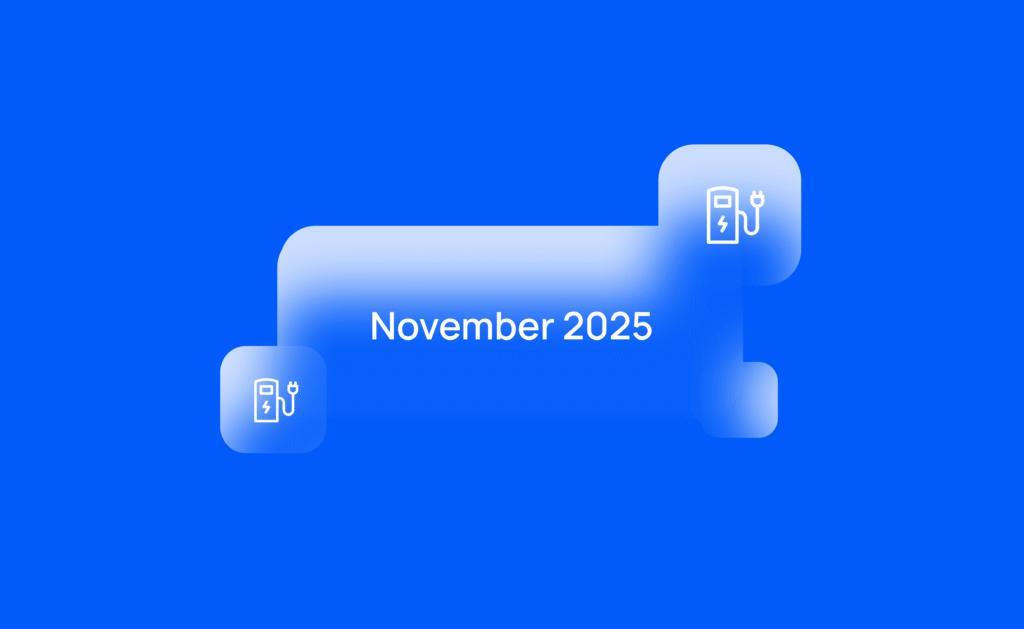On this page
Sign up to our newsletter
Subscribe to receive the latest blog posts to your inbox every week.
By subscribing you agree to with our Privacy Policy.
In commercial real estate, having the right data at the right time has become a key component of smart building portfolio management. Executive leaders are responsible for performance across portfolios that span multiple cities, countries, and time zones. From Chief Innovation Officer to Regional Director to Asset Performance Lead, these executives are responsible for driving operational excellence, reducing energy waste, and—perhaps most importantly—keeping tenants satisfied and renewal-ready.
And yet, in 2025, too many still rely on a patchwork of spreadsheets, PDFs, email threads, and vendor calls to understand what is working and what is not.
Let’s explore what a day in the life of a real estate executive looks like, with and without KODE OS.
7:30 AM – Portfolio Oversight and Vendor Updates
Mornings typically begin in the inbox. An operator in Boston sends a spreadsheet showing utility spikes. A regional director flags an HVAC maintenance issue in Dallas. A vendor escalates a $3,000 trip charge for an urgent repair in San Diego, for a problem that may have been preventable.
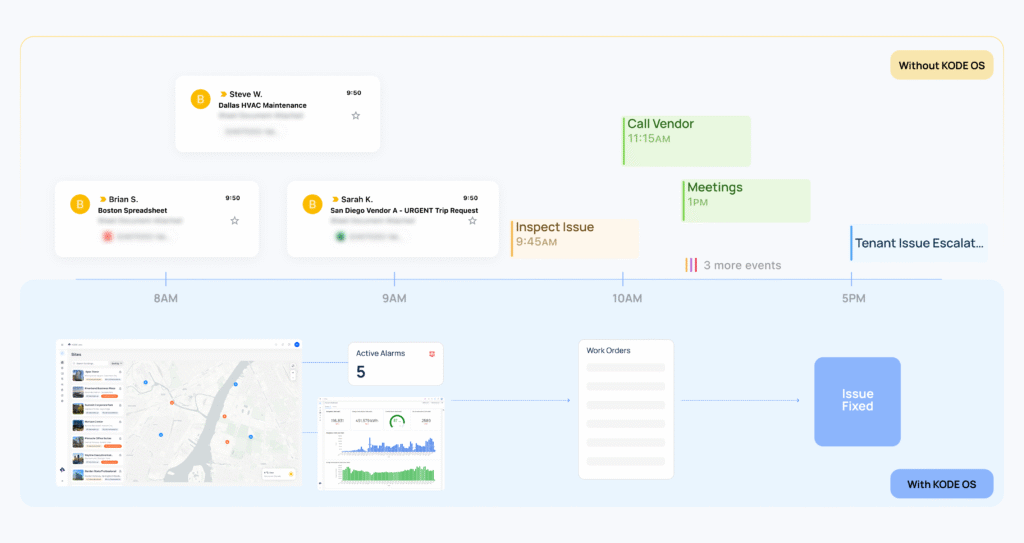
None of these updates is in the same format. Few come with context. Some require follow-ups. Before 9 AM, your calendar’s already at capacity.
That’s where KODE OS quietly transforms your workflow. Instead of waiting for updates, executives have access to real-time insights, alerts, and standardized reporting dashboards that give executives portfolio-wide visibility in a matter of clicks. From West to East, you can pinpoint underperforming assets and make confident, timely decisions.
10:00 AM – Portfolio Management Reporting and Executive KPI Insights
Executives often serve as both the messenger and the bridge. They compile reports for stakeholders, board members, or investment committees. At the same time, they rely on regional and building-level teams to collect and validate that data.
In the traditional setup, much of this involves third-party analytics platforms, such as Power BI, and manual spreadsheets, along with hours of data input. Did the Miami building hit its energy-saving targets? Is the new BMS system in Houston outperforming expectations? What’s the tenant satisfaction trend in New York over the past two quarters?
This kind of reporting complexity is something engineering managers work through daily, just from a different vantage point. Their experience with KODE OS shows how operational clarity at every level feeds smarter decisions at the top.
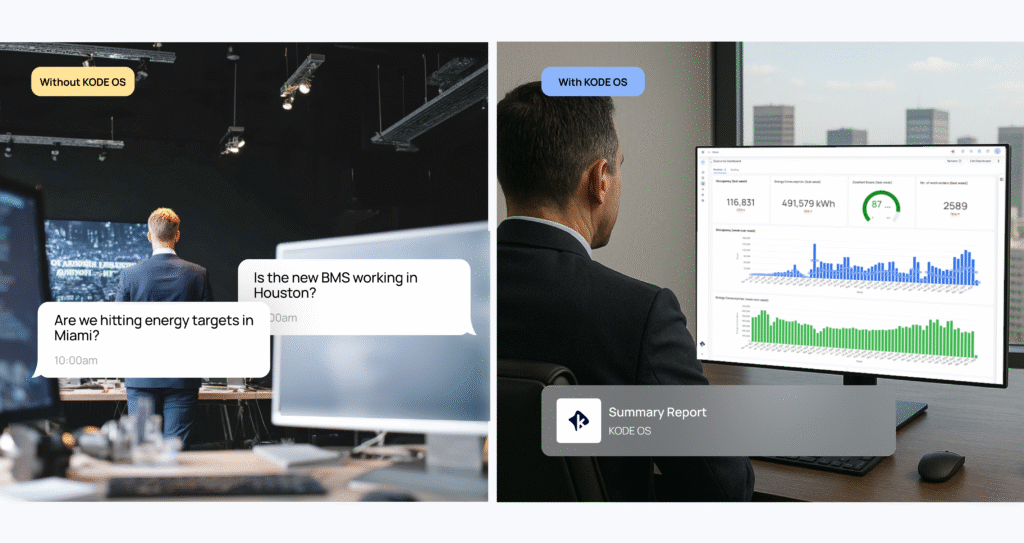
With KODE OS, the numbers are already there—clean, organized, and contextual. Real-time portfolio reports, side-by-side comparisons, trendlines, and historical benchmarked metrics turn reporting from a burden into a strategic asset. One dashboard. One language. One source of truth.
12:00 PM – Tenant Satisfaction and Real-Time Insights
Your phone buzzes: a major tenant has escalated a complaint. Their space is too hot. It’s the third time this quarter, and now they’re hinting at non-renewal. As an executive, you’re tracking space satisfaction metrics across the portfolio to strategically drive those numbers down.
The pressure is on to not only fix the issue but also understand its root cause. What does a trend like this mean for regional performance? For renewal rates?
You scramble to investigate—but who owns the issue? Is it a contractor delay, a control failure, or a missed schedule?
Without data, resolution means phone trees and finger-pointing.
To change this narrative, imagine you immediately pull historical performance, view real-time data from that space, see when it went off schedule, determine if a fault was flagged (but ignored), and even track vendor response times. Suddenly, you’re not just reacting, you’re proacting by showing proof, taking accountability, and making strategic calls based on facts, not hunches. That’s the kind of foresight executives can act on because with KODE OS, all the relevant data is in one place, enabling faster resolution and protecting tenant relationships.
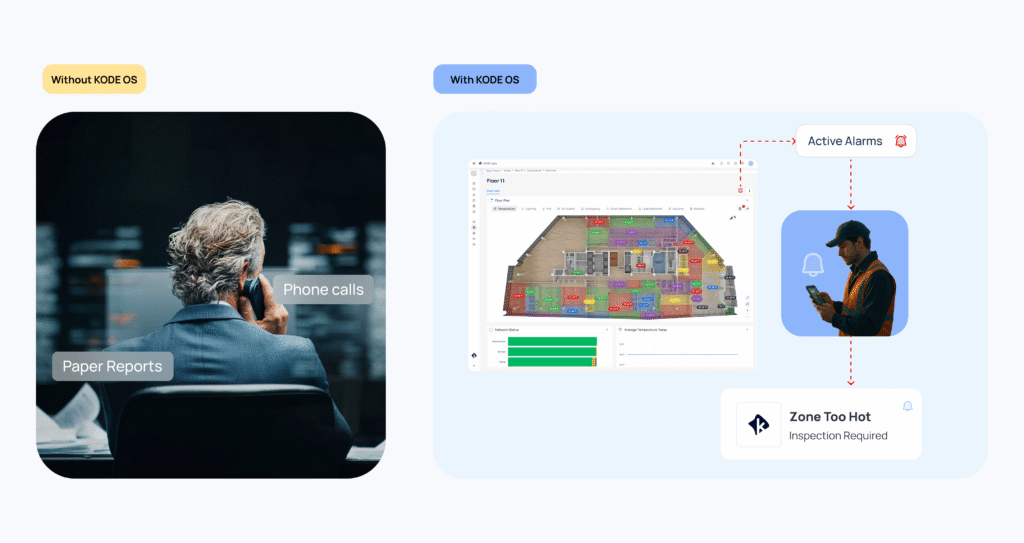
3:00 PM – Scaling Building Success Across the Portfolio
The afternoon is for vision. You’re thinking about playbooks, not problems. How do you replicate what’s working across the rest of the portfolio? Which systems deliver the most ROI? How do you empower your teams without micromanaging? What if every building could learn from the top performer?
Instead of managing buildings in isolation, you want to model for operational excellence. When you have the data, you can scale the impact. That’s the goal.
With mass command and control through KODE OS, you can apply global schedules (e.g., Building A’s 70°F evening reset) across your entire portfolio. You learn that Building A consistently saves more on lighting than Building B, and you can explore the reasons why. Maybe it’s the platform. Perhaps it’s the vendor, the OT, the way you manage buildings, or a lack of proactive maintenance. KODE OS helps you identify patterns that drive decisions.

This kind of operational clarity is what a facility manager experiences daily using KODE OS. Executives now have that same clarity, but with a broader view across entire portfolios.
5:30 PM – Strategic Decisions and Portfolio Leadership
As the day winds down, there are contracts to review, board decks to prepare, and budgets to reconcile. The ability to move fast and smart defines the difference between maintaining and leading.
Instead of sifting through disconnected systems or waiting on weekly updates, KODE OS provides executive-ready views that cut through the noise.
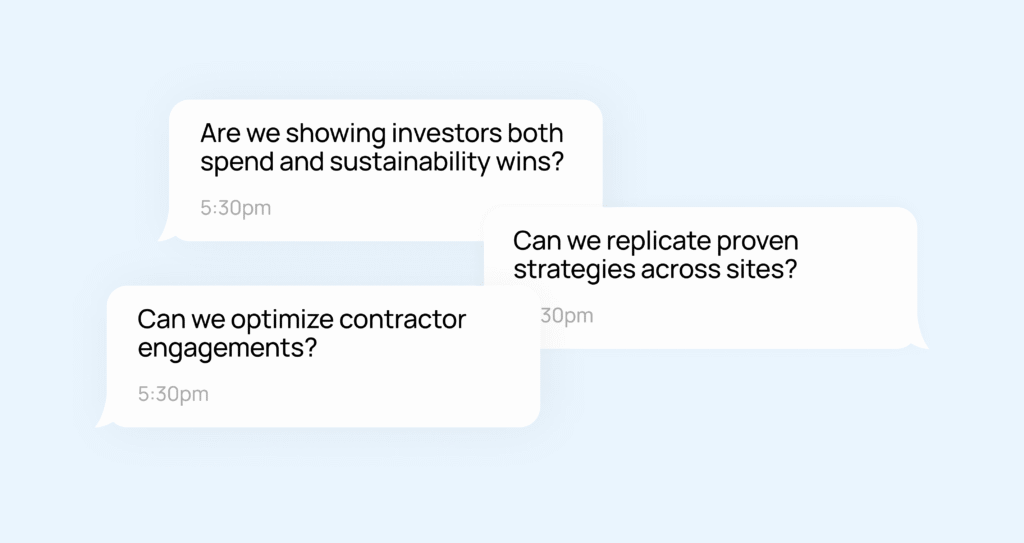
You’re not chasing down problems anymore. Instead, you’re planning the next big move and asking bigger questions: Is it feasible to optimize contractor engagements? Can we successfully replicate proven strategies across different regions? Can we demonstrate to our investors that we’re optimizing both spend and sustainability?
And with KODE OS, the answer is yes! It helps you align global teams and build the kind of consistency that investors and tenants notice and appreciate.
Executive-Level Impact, Built In
At its core, smart building portfolio management depends on visibility, standardization, and proactive decision-making. Real estate executives don’t need more tools—they need smarter ones.
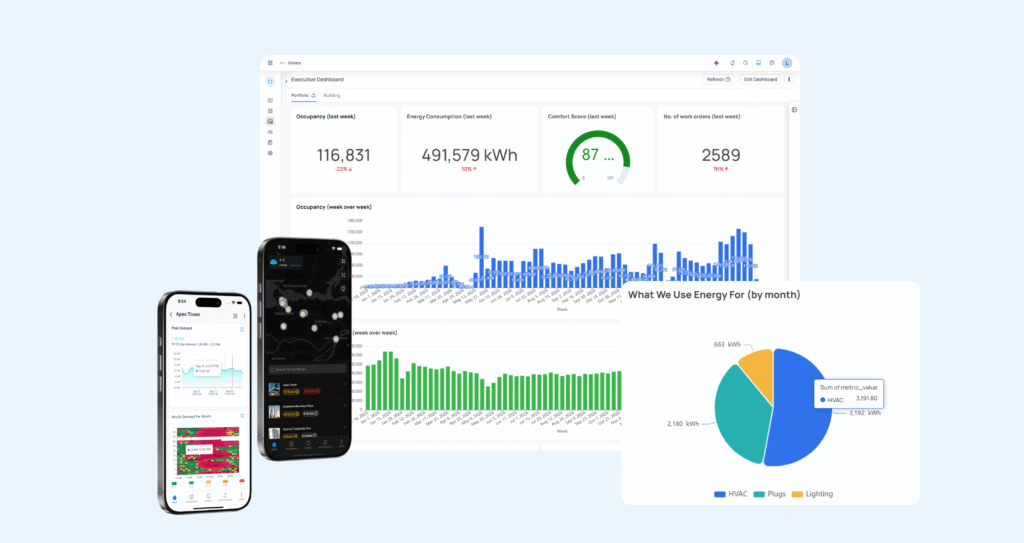
KODE OS empowers leaders to:
- Gain instant, portfolio-wide visibility to make smarter, faster decisions across assets and teams.
- Save time on reporting workflows with real-time dashboards and pre-built templates.
- Benchmark performance across assets, regions, and global portfolios to identify top-performing sites and strategies.
- Make better data-driven vendor decisions with transparency into response times and recurring issues.
- Enhance tenant satisfaction by resolving problems before they escalate.
- Standardize operations at scale to deliver consistency without sacrificing flexibility.
- Elevate executive reporting with clean, shareable dashboards for board, investor, and corporate updates, demonstrating proactive risk management, accountability across regions and vendors, and operational excellence.
And most importantly, it turns data into action, with clarity and purpose.If any part of this day felt familiar or showed you how your operations could run smarter, book a demo to see KODE OS in action.
FAQs
What is smart building portfolio management?
Smart building portfolio management is the process of utilizing real-time data and operational insights to efficiently oversee and optimize multiple buildings.
How does KODE OS support executive decision-making?
KODE OS provides executives with visibility across their entire building portfolio, streamlining reporting, issue identification and resolution, tenant satisfaction, and vendor management.
How does smart building portfolio management reduce costs?
Smart building portfolio management leverages real-time performance data and automation to reduce energy waste, avoid costly contractor visits, and minimize downtime across assets.
